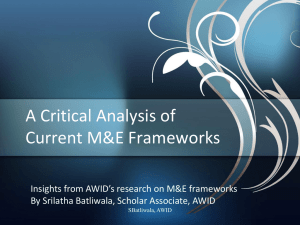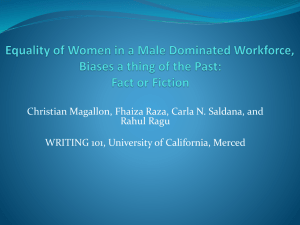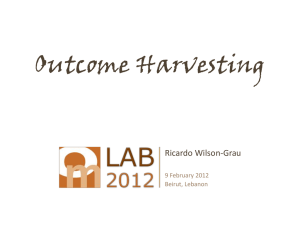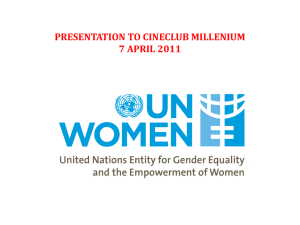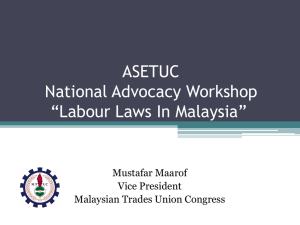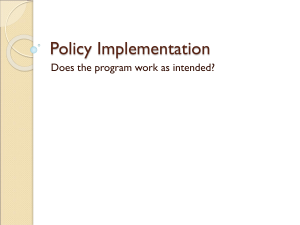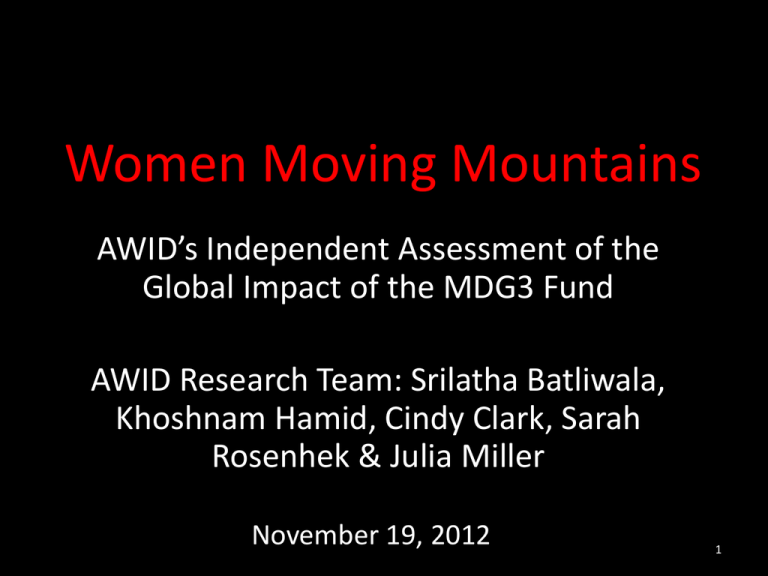
Women Moving Mountains
AWID’s Independent Assessment of the
Global Impact of the MDG3 Fund
AWID Research Team: Srilatha Batliwala,
Khoshnam Hamid, Cindy Clark, Sarah
Rosenhek & Julia Miller
November 19, 2012
1
The Methodology
• “Nuggets” gathered at the mid-term of the grants
(December 2010)
• In-depth interviews conducted between December 2011
& March 2012 on key achievements with selected
grantees
• Survey conducted between August & October 2012
through a partially pre-coded questionnaire
• Survey questionnaire sent to 35 women’s rights
organizations, 25 responded (71% response rate)
• We define women’s rights organizations as organizations
generally est’d by women, whose priority constituency is
women, and working primarily on addressing gender
power structures and women’s rights, rather than more
general development or anti-poverty programs
AWID 2012
2
The Respondents
1. AWDF
2. AWID
3. BREAKTHROUGH
4. Calandria
5. Casa de la Mujer
6. CREA
7. FCAM
8. FIDA Kenya
9. Gender Links
10. Global Fund for Women
11. The Huairou Commission
12. IAWJ
13. JASS
AWID 2012
14. Kvinna till Kvinna
15. MIFUMI
16. NWI
17. Puntos de Encuentro
18. Semillas
19. Trust Africa
20. UAF Africa
21. V-Day Egypt (Karama)
22. WIEGO
23. WIGJ
24. WLP
25. WLUML
3
Where the work was done –
respondents by their regions of work (N=25)
Middle East /
Europe (1)
North Africa
(2)
Australasia /
Pacific (1)
Global /
Transnational
(9)
Asia (3)
Latin America
(5)
Africa (6)
AWID 2012
4
The sectors they represent (N=25)
Movement Women's political
participation and
building /
leadership
Movement
16%
support
organizations
20%
Women's Funds /
Community Funds
20%
VAW / GBV /
Women's Human
Rights
20%
Justice and Legal
Rights
16%
Media and
communications
8%
AWID 2012
5
Where the Mountains
were Moved…
AWID 2012
6
The work of our 25 respondents reached or covered
• 163 Countries,
• 6 continents,
• 15 regions
AWID 2012
7
Latin America
20
Middle East & North Africa
20
19
Eastern & Central Europe
17
Western Europe &…
14
West Africa
Australia & Pacific
10
Southern Africa
10
South East Asia
9
Caribbean
9
Caucasus & Central Asia
8
East africa
8
Where the work
was done :
the regional spread
(N=163)
7
South Asia
6
Central & Equatorial Africa
4
East Asia
2
North America
0
2
AWID 2012
4
6
8
10
12
14
16
18
8
20
Central & Eq’l
Africa
1. Angola
2. Burundi
3. Cameroon
4. Central
African
Republic
5. Chad
6. Dem. Rep.
of Congo
AFRICA
West Africa
1. Benin
Southern Africa 2. Burkina Faso
1. Botswana
3. Cote d'Ivorie
2. Lesotho
4. Eq’l Guinea
3. Madagascar 5. Ghana
6. Guinea
4. Malawi
5. Mozambique 7. Liberia
6. South Africa 8. Mali
9. Niger
7. Swaziland
10. Nigeria
8. Zimbabwe
North Africa
11. Senegal
4. Mauritania 9. Namibia
1. Algeria
12. Sierra Leone
5. Morocco
2. Egypt
10. Zambia
6. Somalia
13. The Gambia
3. Libya
7. Tunisia
AWID 2012
9
14. Togo
East Africa
1. Djibouti
2. Ethiopia
3. Kenya
4. N. Sudan
5. Rwanda
6. S. Sudan
7. Tanzania
8. Uganda
9. Mauritius
Mexico &
Mesoamerica
1.
2.
3.
4.
5.
6.
7.
8.
Belize
Costa Rica
El Salvador
Guatemala
Hondura
Mexico
Nicaragua
Panama
North America
1. Canada
2. The United
States
The Americas & Caribbean
South America
1.
2.
3.
4.
5.
6.
7.
8.
9.
10.
11.
12.
Argentina
Bolivia
Brazil
Chile
Colombia
Ecuador
Falkland Is
Guyana
Paraguay
Peru
Uruguay
Venezuela
AWID 2012
Caribbean
1. Cuba
2. Dominican
Republic
3. Grenada
4. Haiti
5. Jamaica
6. Puerto Rico
7. Saint Lucia
8. Trinidad
9. British Virgin
Islands
10
Caucasus &
Central Asia
1.
2.
3.
4.
5.
6.
7.
8.
ASIA
South Asia
Armenia
Azerbaijan 1. Afghanistan
2. Bangladesh
Georgia
Kazakhstan 3. India
Kyrgyzstan 4. Maldives
5. Nepal
Tajikistan
Turkmenistan 6. Pakistan
Uzbekistan 7. Sri Lanka
East Asia
1. China
2. Hong Kong
South East
Asia
1.
2.
3.
4.
5.
6.
7.
8.
Burma
Cambodia
Indonesia
Malaysia
Philippines
Singapore
Thailand
Timor
L'este
9. Vietnam
3. Japan
4. Mongolia
AWID 2012
Middle East
1. Bahrain
2. Iran
3. Iraq
4. Israel
5. Jordan
6. Kuwait
7. Lebanon
8. Oman
9. Palestine
10. Saudi Arabia
11. Syria
12. U.A.E.
13. Yemen
11
Central &
Eastern Europe
1. Albania
2. Belarus
3. Bosnia and
Herzegovina
4. Bulgaria
5. Croatia
6. Czech
Republic
7. Hungary
8. Kosovo
9. Lithuania
10. Macedonia
11. Moldova
12. Montenegro
Europe
13. Poland
14. Romania
15. Russian Fed.
16. Serbia
17. Slovakia
18. Turkey
19. Ukraine
Scandinavia
1.
2.
3.
4.
Denmark
Iceland
Norway
Sweden
AWID 2012
Western Europe
1.
2.
3.
4.
5.
6.
7.
8.
9.
10.
11.
12.
13.
Austria
Belgium
France
Germany
Greece
Ireland
Italy
Monaco
Netherlands
Portugal
Spain
Switzerland
United Kingdom
12
Australia & The Pacific
1.
2.
3.
4.
5.
6.
7.
8.
9.
Australia
Fiji
Guam
Marshall Islands
New Caledonia
New Zealand
Papua New Guinea
Tonga
Tuvalu
AWID 2012
13
The Big Mountains that
Moved:
Some key achievements of the MDG3
Fund grantees, 2009 - 2011
AWID 2012
14
• At least 220 million people reached with new
awareness of women’s rights
• At least 65 million grassroots women reached
with awareness of their rights
• At least 200,000 activists were provided tools and
skills to support women’s assertion of their rights
• At least 100,000 women’s organizations were
strengthened / provided greater capacity and
tools
• At least 3,400 women’s organizations were
provided new or more resources
AWID 2012
15
• Local and national governments in at least 46 countries
were persuaded / capacitated to improve their gender
equality outcomes
• At least 27 national governments’ gender policies were
positively influenced
• One new international rights instrument (ILO
Convention 189 on Domestic Work) was approved with
Fund-supported “last lap” work
• At least 5 international human rights / women's rights
instruments or institutions ratified / implementation
advanced / influenced (CEDAW, American Human
Rights Commission, etc.)
• At least 85 distinct new interventions / achievements in
advancing gender equality, women’s rights, “holding
the line”, protecting past gains, and preventing /
dealing with backlash!
AWID 2012
16
Five Top Achievements with the MDG3 Fund Grant (N=24)
100
92
92
92
92
92
90
No.
80
70
%
60
50
40
30
22
22
22
22
22
20
10
0
Reached a larger
number of
women /
women’s
organizations
Increased
geographic
coverage
Strengthened
women's
leadership
AWID 2012
Launched new
programs /
strategies
United women /
built new
collective power
17
Next Most Frequent Achievements (N=24)
Other achievements
Tracked reversals / backlash more
effectively
Prevented reversal of past gender equality
gains or achievements
More effective advocacy to change
discriminatory laws/policies
Survived / continued our work in very
challenging contexts
Influenced gender equality work of other
movements, sectors, and organizations
Built alliances with other movements and
organizations
Focused on new issues and constituencies
of women
AWID 2012
0
%
29
7
No.
38
9
42
10
67
16
71
17
83
20
83
20
88
21
10
20
30
40
50
60
70
80 18 90
How did they do it?
15 Core Strategies Used
1.
2.
3.
4.
5.
6.
7.
Scaling up / increasing
coverage
Increasing resources
Building public awareness /
support for women’s rights
Increasing women’s awareness
of / access to their rights
Building organizational and
strategic capacity from
grassroots to global levels
Influencing multilateral and
government policies / laws /
practices at different levels
Increasing women’s political
participation and access to
public decision-making
8.
9.
10.
11.
12.
13.
14.
15.
AWID 2012
Movement Building /
increasing collective power
Research and knowledge
generation
Creating new tools / concepts /
methods / strategies
Building alliances, networks,
cross-movement solidarity
Birthing new organizations /
initiatives
Using media, communications,
and ICTs for awareness,
campaigns, advocacy, pressure
Urgent action
Fighting backlash, regression,
“holding the line”
19
Key shifts in gender power relations (N=25)
Individual
Consciousness /
Internalized
attitudes, selfesteem
Informal
Access to &
control over
resources /
services
Community
Formal
Laws, policies,
resource
allocations
Cultural / social
norms, beliefs,
practices
Systemic
AWID 2012
20
AWID 2012
Nature of shifts in individual consciousness /
self-confidence (N=23)
90%
83%
80%
70%
70%
61%
65%
60%
50%
40%
43%
30%
30%
20%
10%
0%
Increased
decision
making ability
Change in
personal
attitudes
Increased
self-esteem
& confidence
Increased
voice and
participation
Increased
Increased
leadership & awareness/
advocacy
knowledge of
capacity
rights
21
Nature of shifts in cultural norms and
practices (N=21)
Increased support for women's rights in
communities & local authorities
86%
Increased public dialogue/awareness /
shifts in public discourse
62%
Media coverage & use of media to raise
gender issues
43%
Changes in traditional forms of genderdiscrimination / division of labor
29%
Emmergence / strengthening of
movements
AWID 0%
2012 10%
24%
20%
30%
40%
50%
60%
70%
80%
22
90%
Nature of shifts in individual access to
resources & rights (N=20)
35%
Other shifts ind'l / formal domain
Stronger manifestations of exercise of
leadership
65%
Greater voice / political participation /
role in decision-making
50%
Visible increase in access to / assertion of
rights
40%
Increased access to resources, secure
livelihood & economic opportunities
30%
Greater visibility, security & justice for
WHRDs
AWID0%
2012 10%
20%
20%
30%
40%
50%
60%
23
70%
Nature of shifts in formal laws, policies
& resource allocations (N=20)
Stronger laws/policies/quotas/instns for
women
80%
Recognition of imp'ce of women's rights
within gov'ts / mult'l processes
35%
30%
Increased resource allocations
25%
Evidence to inform future advocacy
Improved quality of public programs &
services
Other shifts in the formal systemic
domain
AWID
0% 201210%
20%
15%
20%
30%
40%
50%
60%
70%
24
80%
What was achieved towards
Advancing the MDG3 Fund goals
AWID 2012
25
No. of organizations that advanced
each MDG3 Fund core goal (N=25)
90
80
70
60
50
40
30
20
10
0
84
76
20
5
24
6
19
Increasing
enhancing
women's
Increasing
women's
property &
women's
economic
inheritance
independence representation
rights
& participation
in politics
AWID 2012
%
21
No.
reducing
violence against
women
26
First ever study measuring
the cost of VAW in Egypt
(KARAMA)
Pathbreaking
research on violence
against uniquely
marginalized women
(CREA)
Gave millions of
women new
awareness to fight
GBV (BT, Casa, GL,
IAWJ, FIDA, AWDF)
Built capacity of
hundreds of
thousands of
individuals and
organizations to
work on GBV (BT,
Casa, FIDA)
Placed VAW in public
consciousness & mobilized
communities to act against
it (BT, WLUML)
Placed VAW & violence against
WHRDs on national agenda,
catalyzed new GBV legislation
(BT, GFW partners,
Innovative multimedia mass
campaign on VAW that reached
millions (BT, Calandria, Puntos)
Reducing /
Preventing GBV
Created new tools,
and concepts
(“Sextortion”)
(IAWJ, GL, Casa,)
Improved
response of
duty bearers
(MIFUMI)
Stronger and more effective
mechanisms to prevent
violence against women
(Calandria,
MIFUMI)
AWID 2012
Enhanced safety & built
alliances of women
activists working in highrisk contexts (JASS, FCAM,
AWID, KVINNA)
Increased reach of
legal assistance and
access to redress
(Casa, FIDA, MIFUMI)
Raised visibility of
Women Human Rights
Defenders and the
increasing violence
against them (AWID,
JASS, FCAM)
27
“Last lap” advocacy
for passing of ILO
Covenant 189 on
domestic work
(WIEGO)
Increased assets
and resources of
marginalized
women (MIFUMI,
Semillas)
Enhanced women’s
rights activists
presence &
priorities in global
policy processes
(Paris/Accra/Busan),
inclusion of
language on gender
equality in outcome
documents (AWID)
Enhanced women’s
awareness of their rights and
legal rights (several)
Influenced constitutions to
strengthen gender equality
provisions (WLP, Karama)
Women Reclaiming and Redefining Culture
programme to challenge interpretation of
women’s property & inheritance rights
(WLUML)
Enhanced poor
women’s access to
savings / credit /
financial security
(MIFUMI)
Economic
Independence &
Property &
Inheritance Rights
Built capacity of
community groups on
labor and property
rights (MIFUMI, HC
Semillas)
AWID 2012
Claiming Equal
Citizenship
Campaign and family
law reform in MENA
countries (WLP)
Advanced
women’s
labor rights
and
customary
property
rights
(Semillas,
FIDA)
28
Built a cadre of strong
women leaders at the
regional and national levels
of politics who have the
power to leverage influence
(WLP, Semillas)
Integration of
informal workers
into urban
planning policies
(WIEGO)
Enhanced women’s
rights activists presence
and participation in key
global policy processes
(AWID)
New international & national
norm structures & laws
(WIEGO, FCAM, Karama,
GFW, Casa, Gender Links)
Increased access of
grassroots’ women’s to
decision-making
structures and processes
(Gender Links, HC)
Political
Empowerment
Impact on ICC - gender
based charges included in
six out of seven conflict
situations and in 11 out of
15 cases (WIGJ)
increased the capacity of
women’s organizations &
individuals to participate
in key conversations
(NWI, JASS,AWID,
Karama, WLP, FCAM,
Calandria)
Strengthened
understanding of
and responses to
religious
fundamentalism
(AWID, CREA)
Increased induction of
women into government
offices (FIDA, )
Increased support for
Improved government and local
women’s rights
authorities’ gender equality work
assertions by duty
(CALANDRIA, Casa, Gender Links)
AWID
2012
29
bearers
(MIFUMI)
Advocacy Achievements
AWID 2012
30
Forms of Advocacy Enabled by the Fund (N=20)
Media-based advocacy
5
Research for advocacy
7
Political and legal advocacy
9
Created new laws, bills, policies
11
More effective engagement with national,
regional and international policy bodies
11
Advocacy Meetings/Actions / mobilizations/
protests
14
0
AWID 2012
2
4
6
8
10
12
1431
Policy Impact by
Issue
1. GBV/Violence against
Women (UAF, AWDF, GFW)
2. Civic education (AWDF,
FIDA,
3. Land & property rights (
JASS, Huairou, Casa de la
mujer, Kvinna, MIFUMI)
4. Labor rights (WIEGO, FIDA)
5. Women victims of armed
conflict and displacement
(Casa de la mujer, WIGJ)
6. Family laws & Citizenship
rights (WLP, Karama)
Policy impact by
constituency
1. Women citizens (Karama,
MIFUMI, FIDA, FCAM)
2. WHRDs (AWID, Kvinna,
FCAM, JASS)
3. Home based workers
(WIEGO)
4. Domestic Workers - WIEGO
5. Women Farmers - JASS
6. Grassroots women –
Huairou, JASS, Puntos, Casa)
7. Disabled, lesbian and sex
workers (CREA)
AWID 2012
32
Example: At least 27 countries influenced in their
national gender policies / UN commitments
Brazil
Indonesia
Mongolia
Mongolia
Columbia
Jordan
Morocco
Tanzania
DRC
Kenya
Nicaragua
Thailand
El Salvador
Liberia
Nigeria
Timor Leste
Ghana
Libya
Philippines
Lebanon
Guatemala
Malawi
South Africa
Iraq
India
Mauritania
Sudan
The following nine countries will be included when they ratify ILO Convention 189, which
they have committed to do through MDG3 Fund-supported advocacy
Costa Rica
Jamaica
Peru
Dominican Republic
Kenya
Philippines
Ghana
Namibia
AWID 2012
Tanzania
33
1. Gender just laws and policies:
MIFUMI: By investigating,
documenting and reporting on
violations of women’s property and
inheritance rights, succeeded in
mobilizing support for the domestic
violence bill (passed in Nov 2009),
land bill amendments, and stronger
constitutional provisions
FIDA: contributed
towards the
adoption of the
Kenya Sexual
Offences Act, 2006
in 2008
WLP Jordan/SIGI/J
provided the Jordanian
constitutional reform
committee with
recommended
amendments for
women’s rights
AWID 2012
34
2. Prevention/defeating discriminatory,
regressive and gender unjust laws:
Karama: President of
network member Syrian
Women’s League lobbied
each parliamentarian to
prevent the passage of a
more restrictive personal
status law, supported by the
survey of public attitudes
showing support for a more
liberal personal status code
Casa de la Mujer:
presented political and
legal arguments to
oppose regressive
measures on sexual and
reproductive rights in
Colombia
AWID 2012
AWDF: Mobilised to
resist negative legislation
and policy - such as the
Anti Homosexuality Bill
in Uganda, the Indecent
Dressing Bill in Nigeria
35
3. Shifts in values, social norms,
attitudes and consciousness
AWID 2012
36
4. Increased visibility, knowledge, voice
and solidarity among movements:
WIEGO: organizations of domestic workers, home-based
workers and street vendors linked up and gained access to
the policy bodies that affect their work and lives. They also
lobbied other women’s movements in support of
ratification of ILO Convention 189 – such as KUDHEIHA
Workers in Kenya – and partly as a result, the Kenyan
government has committed to ratify the Convention…
Semillas’ grantees began gaining recognition
at community assemblies; while the
realization of women’s agrarian rights is
minimal (518 women
have received land ownership) but these
cases have set an important precedent.
AWID Forum on “The Power of Movements”
created new knowledge on women’s movements
and stimulated new attention to movementbuilding and new alliances
AWID 2012
37
5. Created public pressure and visibility
for women’s rights issues:
BREAKTHROUGH’s
“Bell Bajao”
campaign and
community
mobiliztions
WLUML: Koalisi NGO Ham-Aceh,
strengthened public awareness of
the discriminatory nature of the
the Qanun Jinayat legislation,
which allows violent punishments
of such 'crimes' as adultery,
homosexuality, gambling
AWID 2012
38
Advocacy impacts at global level
• “Last lap” work for creation of UN Women
• ILO Convention 189 on Domestic Work
• Women’s voices and gender perspective in major
multilateral policy events at Accra, Busan, New
York, etc.
• Quotas for women in civil society participation at
major multilateral policy events
• Gender equality language – entirely missing
earlier) – in many policy documents (OECD/DAC)
• Creation of FRIDA – young feminist fund
AWID 2012
39
How the MDG3 Fund Built
Organizational Capacity
AWID 2012
40
The Five Top Ways the Fund
Strengthened Organizations (N=24)
Increased our credibility /
legitimacy
83
20
Strengthened organizational
systems
79
19
79
Increased staff size
19
Enhanced role of younger
women activists
58
14
%
Other ways in which our
capacity was built
42
No.
10
0
AWID 2012
20
40
60
80
100
41
How The MDG3 Fund’s Design
Enabled These Achievements
AWID 2012
42
Unique Advantages of the MDG3 Funding (N=25)
Unique (large) scale enabled work
expansion / greater outreach
84
21
Supported core work and shaped
org'l processes
72
18
Flexibility in issues / strategies
supported and allowing change…
68
17
3 year duration helped achieve more,
provided sustainability
44
11
Enhanced credibility, helped leverage
other grants
%
36
9
0
AWID 2012
20
40
No.
60
80
43
100
Unpacking the value of these
modalities…
Some examples of why each of these
facets of the Fund’s design mattered
AWID 2012
44
Examples of why size mattered
• The MDG3 Fund allowed for new projects to be
developed and supported, and helped reach new
constituencies of marginalized women:
– Semillas’ initiative on women’s rights to land
– TrustAfrica’s new areas of work on VAW and women’s
political participation
– BREAKTHROUGH’s expanded work on VAW and DV to
address other manifestations of violence (such as early
marriage and sex selective abortion)
– CREA’s Count Me In project uncovered violence against
disabled, lesbian and sex worker women; and could regrant to the organizations of these women to make these
”really small, poorly resourced organisations, financially
sustainable.”
AWID 2012
45
Examples of why core support mattered
• Allowed for organizational strengthening work, of their own and
ally organizations
• Grew the organization (staff size, scope, offices) – allowed for
salary expenses to be covered, which many project grants do not
• Supported the creation and systematization of knowledge – rare
in today’s funding environment
• Allowed for purchase of equipment & upgrade infrastructure
• Could work on issues / with constituencies for which project
funding was difficult to find
• While these investment in organizational development were
valued, such formalization often compromises flexibility and
responsiveness. Respondents appreciated the fact that the Fund’s
support allowed them to maintain a good balance
AWID 2012
46
Examples of why flexibility mattered
• Karama reports it allowed them “to be responsive to
emerging issues and dramatic shifts in the political context
and [to] our partners, particularly during and after the
Arab uprisings.”
• Casa de la Mujer states, “The openness and solidarity of
the people at the MDG3 Fund and the Ministry let us make
the necessary adjustments to take care of risky and
emergency situations to protect women’s lives and
integrity.”
• The Huairou Commission says it allowed “our members to
focus on aspects of women’s empowerment and gender
equality which they prioritized – leadership, collective
organizing, resource sovereignty, accountability and
responsiveness (of government and institutions), and
knowledge management and communications.”
AWID 2012
47
Examples of why leveraging other
resources mattered
• AWDF was able to use the funding from MDG3 to leverage
additional resource, support and encourage innovation, and
thus invest in “new ways to ‘do women’s rights work’. In that
sense the partnership has enhanced the organisation’s ability
to grow, broaden its influence, and bring new publics to the
table.”
• V Day Egypt (Karama) says:This [funding] helped
internationalize the issues and the women’s groups, and …
provide[d] a level of protection. It’s more difficult to shut down
an alliance of women’s groups when there is international
government funding.
• NWI says: Through this project, our profile has been enhanced
so that we are well regarded and sought after by multilateral
organizations, national governments, academic institutions,
media outlets and other members of civil society for the skills
and expertise we can offer.
AWID 2012
48
Examples of why multi-year funding
mattered:
• Multiannual funding meant that new programs had
time to evolve and could show some initial results.
• Groups felt they achieved more because of the
cumulative nature of the work and ability to focus on
the work (rather than fresh fundraising)
• The extension of the grant helped support the
transitioning of projects supported by the MDG3 fund.
• Timing of the fund was also fortuitous – these grants
were approved just as the financial crisis was really
hitting and supported these groups through a difficult
period when many other donors were pulling back.
AWID 2012
49
And why the grassroots-to-global
funding mattered
• In today’s globalized and highly integrated policy
environment, women cannot create systemic change
by working solely at the grassroots level. But global
advocacy agendas uninformed by grassroots
priorities are not legitimate
• Economic policies and development cooperation
agendas, have to be challenged or influenced
globally by organizations working at the grassroots,
national, regional and global levels
• Similarly, important norm structures like human
rights and labor standards are created by
multilateral institutions that must be influenced
through global advocacy.
AWID 2012
50
And why the grassroots-to-global
funding mattered - 2
• Forces like religious fundamentalism, criminal networks
and conflict also need to be challenged and resisted
through well-coordinated action at both local, regional,
and global levels
• Global spaces for women to convene, refresh their
knowledge, agendas and strategies are critical in
today’s reality
• The fund’s support of groups like AWID, IAWJ, NWI,
WIEGO, and WIGJ, enabled vital global advocacy and
achievements (ILO 189, DAC language on gender
equality, global hearings, ICC judgements, etc.) while
simultaneously advancing women’s empowerment on
the ground
AWID 2012
51
In summary….
• If just over half the MDG3 Fund recipients could
• Get millions of people around the world thinking differently
about the rights of women…
• Build the capacities of hundreds of thousands of gender equality
activists and women’s rights advocates…
• Launch an array of new initiatives and strategies that created
new voice, participation, and resources for women, confronted
violence, and reshaped public programs and policies in myriad
ways from the local to the global…
• Strengthen organizations and movements for gender equality
who don’t plan to go away…
AWID 2012
52
If women could move such mountains with a mere
70 million Euros, what could they do with a 100,
with 500, with a billion??
….. They could transform
the entire world!
AWID 2012
53
But in reality:
• Women’s rights organizations get very little support
for their work…
• “….women’s rights organizations, networks and
movements are drastically underfunded, making up
less than 10% of philanthropic giving in both Europe
and the United States.” Caitlin Stanton, 2012, “Breaking
Through – The Global Fund for Women Impact Report: Gender
Equality in Asia and the Pacific“, San Francisco, Global Fund for
Women, P.6,
• AWID’s most recent WITM survey found the median
income of women’s rights organizations is $20,000 per
annum (and as low as $13,000 in some regions)
AWID 2012
54
The OECD’s Development Assistance
Committee (DAC) says:
• “…. data (sector code 15170 on funding to
women’s organizations and institutions), shows
that [only] $331.8 million dollars in the 2010
budget went to women’s organizations and
gender institutions (including national
machineries) –
• “this represents [only] 1.3% of all DAC screened
funds dedicated to gender equality ($24.9
billion)”
• It is
AWID 2012
55
A Critical Post Script!
“….significantly increased levels of
financial and human resources will be
needed for a number of years to
safeguard the gains made in gender
equality…”
AWID 2012
56
“Holding the Line”
/ Dealing with backlash & fundamentalism
• Protecting gender just laws and policies / advancing
new ones to neutralize backlash
• Prevention/defeating of discriminatory, regressive and
gender unjust laws
• Positive changes in consciousness, social norms and
attitudes, and greater self-esteem
• Increased visibility, knowledge, voice and solidarity
among movements
• Created public pressure and visibility for women’s
rights issues
• Protected and strengthened WHRDs at risk, and
promoted self-care, security, and wellbeing of all
WHRDs
AWID 2012
57
Shifts achieved at individual & systemic
levels & in formal and informal domains
92
Perceivable shifts in consciousness /
self-esteem
23
88
Perceivable shifts in laws, policies &
resource allocations
22
84
Perceivable shifts in individual access
to resources & rights
21
%
84
Perceivable shifts in cultural norms
and practices
No.
21
0
10
20
AWID 2012
30
40
50
60
70
80
90
100
58
Enhanced Credibility with Key
Actors(N=20)
90
No.
80
70
%
71
67
60
83
83
50
40
8
30
20
10
2
0
Others
(specify):
16
Policy makers /
government
officials
17
Other NGOs /
civil society
organizations
AWID 2012
20
20
Other donors
Other women’s
organizations /
movements
59
Examples of why size mattered
• The MDG3 Fund allowed for new projects to be
developed and supported, and helped reach new
constituencies of marginalized women:
– Semillas’ initiative on women’s rights to land
– TrustAfrica’s new areas of work on VAW and women’s
political participation
– BREAKTHROUGH’s expanded work on VAW and DV to
address other manifestations of violence (such as early
marriage and sex selective abortion)
– CREA’s Count Me In project uncovered violence against
disabled, lesbian and sex worker women; and could regrant to the organizations of these women to make these
”really small, poorly resourced organisations, financially
sustainable.”
AWID 2012
60
Examples of why core support mattered
• Allowed for organizational strengthening work, of their own and
ally organizations
• Grew the organization (staff size, scope, offices) – allowed for
salary expenses to be covered, which many project grants do not
• Supported the creation and systematization of knowledge – rare
in today’s funding environment
• Allowed for purchase of equipment & upgrade infrastructure
• Could work on issues / with constituencies for which project
funding was difficult to find
• While these investment in organizational development were
valued, such formalization often compromises flexibility and
responsiveness. Respondents appreciated the fact that the Fund’s
support allowed them to maintain a good balance
AWID 2012
61
Examples of why flexibility mattered
• Karama reports it allowed them “to be responsive to
emerging issues and dramatic shifts in the political context
and [to] our partners, particularly during and after the
Arab uprisings.”
• Casa de la Mujer states, “The openness and solidarity of
the people at the MDG3 Fund and the Ministry let us make
the necessary adjustments to take care of risky and
emergency situations to protect women’s lives and
integrity.”
• The Huairou Commission says it allowed “our members to
focus on aspects of women’s empowerment and gender
equality which they prioritized – leadership, collective
organizing, resource sovereignty, accountability and
responsiveness (of government and institutions), and
knowledge management and communications.”
AWID 2012
62
Examples of why leveraging other
resources mattered
• AWDF was able to use the funding from MDG3 to leverage
additional resource, support and encourage innovation, and
thus invest in “new ways to ‘do women’s rights work’. In that
sense the partnership has enhanced the organisation’s ability
to grow, broaden its influence, and bring new publics to the
table.”
• V Day Egypt (Karama) says:This [funding] helped
internationalize the issues and the women’s groups, and …
provide[d] a level of protection. It’s more difficult to shut down
an alliance of women’s groups when there is international
government funding.
• NWI says: Through this project, our profile has been enhanced
so that we are well regarded and sought after by multilateral
organizations, national governments, academic institutions,
media outlets and other members of civil society for the skills
and expertise we can offer.
AWID 2012
63
Examples of why multi-year funding
mattered:
• Multiannual funding meant that new programs had
time to evolve and could show some initial results.
• Groups felt they achieved more because of the
cumulative nature of the work and ability to focus on
the work (rather than fresh fundraising)
• The extension of the grant helped support the
transitioning of projects supported by the MDG3 fund.
• Timing of the fund was also fortuitous – these grants
were approved just as the financial crisis was really
hitting and supported these groups through a difficult
period when many other donors were pulling back.
AWID 2012
64
And why the grassroots-to-global
funding mattered
• In today’s globalized and highly integrated policy
environment, women cannot create systemic change by
working solely at the grassroots level. But global advocacy
without grassroots linkages is also problematic
• Economic policies and development cooperation agendas,
for instance, cannot be effectively challenged or
influenced through grassroots activism – they must be
engaged at the global level, but in ways informed by
grassroots priorities
• Similarly, important norm structures like human rights and
labor standards are created by multilateral institutions
that must be influenced through global advocacy.
AWID 2012
65
And why the grassroots-to-global
funding mattered - 2
• Forces like religious fundamentalism, criminal networks
and conflict also need to be challenged and resisted
through well-coordinated action at both local and
global levels
• Global spaces for women to convene, refresh their
knowledge, agendas and strategies are critical in
today’s reality
• The fund’s support of groups like AWID, IAWJ, NWI,
WIEGO, and WIGJ, enabled vital global advocacy and
achievements (ILO 189, DAC language on gender
equality, global hearings, ICC judgements, etc.) while
simultaneously advancing women’s empowerment on
the ground
AWID 2012
66
Supplementary Data
AWID 2012
67
The survey questionnaire
1. If you were to name five key achievements of
your MDG3 Fund-supported work, what would
they be? (Please describe briefly)
2. What were the main advantages (up to 5) of the
MDG3 Fund type of grant compared to other
grants / funds you have received for your work?
3. How did the MDG3 Fund impact your
organization’s work for advancing women’s
rights / gender equality? (tick as many as
you think apply to your organization)
AWID 2012
68
Question 3 pre-coded options:
a.
b.
c.
d.
e.
f.
g.
h.
i.
j.
k.
l.
m.
We were able to reach / serve / support / empower a larger number of women / women’s
organizations
We were able to increase our geographic coverage or reach or work in new communities /
areas / provinces / countries / regions
We were able to strengthen the number of women in leadership roles / quality of women’s
leadership at different levels
We were able to launch new initiatives, programs or strategies to increase our effectiveness
We were able to focus on new issues or new constituencies of women, or reach / involve a
more diverse range of women (e.g. indigenous women, young women, etc. etc.)
We were able to bring women / women’s organizations together across various divides and
build collective power and identity
We were able to build alliances with other movements and organizations
We were able to influence the gender perspectives / strategies of other movements, sectors,
and organizations
We were able to do more effective advocacy to change discriminatory laws, policies, etc.
We were able to prevent the rolling back / reversal of past gender equality gains or
achievements
We were able to track reversals, backlash, and challenges to change more effectively
We were able to survive / continue our work in very challenging contexts
Other impacts on our organization’s work not listed above (please describe briefly):
AWID 2012
69
4. Please help us by quantifying some of these
impacts as accurately as possible:
BEFORE
AFTER
Before receiving the MDG3 Fund
grant, we reached (approx.) this
many women:
(e.g., 10,000)
After receiving the MDG3 Fund
grant, we reached (approx.) this
many women:
(e.g. 17,000)
[If you are a women’s fund or
network] Before receiving the
MDG3 Fund grant, we reached
(approx..) this many organizations:
(e.g., 47)
After receiving the MDG3 Fund
grant, we reached (approx.) this
many organizations:
(e.g. 75)
Before receiving the MDG3 Fund
grant, our total staff strength was:
(e.g. 23)
After receiving the MDG3 Fund
grant, our total staff strength
was:
(e.g. 40)
Our geographic coverage before
(e.g. 7 provin- Our geographic coverage after
the MDG3 Fund grant: (use
ces/ 8
the MDG3 Fund grant:
whatever measure is most relevant countries)
to your work: provinces, cities,
states, countries, regions)
AWID 2012
(e.g. 10 provinces / 14
countries)
70
5.
If the MDG3 Fund grant enabled you to launch new programs or strategies, or to
deepen, strengthen, or expand existing programs or strategies, please describe
these briefly or share links to / or attach reports where we could find this
information:
a.
b.
c.
d.
e.
5.
If the grant enabled you to do more effective advocacy to change discriminatory
laws, policies, etc., please describe these efforts briefly below:
a.
b.
c.
d.
e.
6.
….
….
….
….
….
….
….
….
….
….
If the grant helped you prevent the rolling back / reversal of past gender equality
gains or achievements, please describe these briefly, or insert links to / attach
relevant reports that discuss this:
a.
b.
c.
d.
e.
….
….
….
….
….
AWID 2012
71
8. Many MDG3 Fund recipients reported, in our interviews with
them late last year, that the grant enhanced the capacity of
their organizations in different ways. Please tell us if the
grant has enhanced your organizational capacity in any of the
following ways: (tick as many as apply)
a.
b.
c.
d.
e.
Increased participation and role of younger women activists in the organization
Allowed us to increase staff size
Allowed us to invest in developing stronger organizational systems (finance, M&E, human
resources, etc.)
Increased our credibility / legitimacy as an organization with (tick as many as apply):
• Other donors
• Policy makers / government officials
• Other NGOs / civil society organizations
• Other women’s organizations
• Others (specify):
Other ways in which our organizational capacity has been strengthened:
• …
• …
• …
• …
AWID 2012
• …
72
9.
We know that advancing women’s rights and gender equality involves
changes at individual, community and societal levels, and in both the
formal domain of law and policy as well as the informal arena of culture,
beliefs, norms, and practices. The Gender at Work framework provides a
way of analyzing changes in all these. [Please]share with us, briefly, even
small shifts or changes that the MDG3 Fund grant helped you advance or
accelerate, in each of these gender equality domains
Tracking change in gender power
rela ons / structures (G@W framework):
Individual
1.
Changes in consciousness (values, a tudes,
awareness of rights) / greater self-esteem
1.
Greater access to & control over resources
like land, house, money
2.
Changes in individual prac ces / behaviour
2.
3.
Enhanced capaci es (leadership, advocacy,
mobilizing others, etc.
Greater Access to public power / poli cal
representa ons / formal leadership
3.
Be er access to public services / legal rights
4.
More repor ng / prosecu on of VAW
offenders
4.
Greater access to power / leadership within the
household, or within informal / customary
ins tu ons like the tribal council, etc.
Informal
Formal
1.
Shi s in cultural norms, beliefs, prac ces
1.
2.
Shi s in judgments given by customary law bodies
like tribal councils, family elders, etc.
More gender-equal laws, policies &
resource alloca ons
2.
Quotas for women in poli cal ins tu ons?
3.
Greater acceptance of women’s rights
3.
4.
More / stronger women’s rights movements
emerging
Na onal gender equality machinery
improved, strengthened, more
accountable?
AWID 2012
Courtesy Rao & Kelleher, 2005
Systemic
73
3
a.
b.
c.
Perceivable shifts / changes, if any, at the level of consciousness /attitudes / awareness of rights at the
individual level, including among women themselves, during the grant period:
I.
…
II.
…
III.
…
IV.
…
V.
…
Perceivable shifts / changes, if any, at the level of cultural norms, attitudes, practices, within the
community / society during the grant period:
I.
…
II.
…
III.
…
IV.
…
Perceivable shifts / changes, if any, at the level of individual rights, access to resources, or access to
public decision-making or leadership roles:
I.
II.
III.
IV.
…
…
…
…
a.
d.
Perceivable shifts / changes we have observed, if any, at the level of formal laws, policies, or resource
allocations
I.
…
AWID 2012
74
II.
…
10. Please describe any other ways expected or unexpected outcomes
of your MDG3 Fund – supported work that are not reflected in the
answers to the previous questions:
•
•
•
•
•
….
….
….
….
….
Thank you very much for your
valuable time and information!
Optional
Name of Organization:
Location:
Name and email address of the person who filled this questionnaire (in
case of the need for any follow-up or clarifications:
AWID 2012
75
Advantages of the Fund resources:
• Unique scale: the size of grants enabled major
expansion - geographically, demographically, issue- and
strategy-wise
• Support for organizational development processes /
'core' support: enabled organizations to strengthen
infrastructure and scale-up / scale-out their work
• Support for diverse issues/strategies and allowing for
changes along the way: the Fund supported activities
(like meetings) that many others don't; it allowed for
combinations of strategies; and increased ability to be
responsive to contextual changes (e.g. our center was
bombed!)
AWID 2012
76
Advantages of the Fund resources:
• Legitimizing role: the scale of resources, the thorough
selection process, and stature of being a Fund recipient
conferred enhanced their credibility and ability to
leverage other resources by showing they could handle
large resources
• Multi-year funding enhanced organizational stability,
consistency, consolidation & impact
• By allowing for sub granting, resources could be
channeled to small, informal women’s groups who could
not otherwise access such funding
• Most importantly, the Fund supported work from the
grassroots to the regional to the global, enabling impact
at multiple levels
AWID 2012
77

